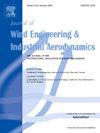Control of unexpected wind-induced vibration of an in-service cable-stayed bridge using vortex generators
IF 4.9
2区 工程技术
Q1 ENGINEERING, CIVIL
Journal of Wind Engineering and Industrial Aerodynamics
Pub Date : 2025-03-14
DOI:10.1016/j.jweia.2025.106079
引用次数: 0
Abstract
Nine years after opening, a cable-stayed bridge with steel-concrete composite girder in China was found to experience unexpected large-amplitude wind-induced vibrations (WIV) under typical wind speeds (approximately 10 m/s). Aerodynamic configuration inspection and field measurement were conducted immediately to investigate the cause of it. Field measurement indicated that the structural damping of the bridge girder was as low as 0.2%–0.4%, differing significantly from the assumed values of the recognized design codes. The unexpected WIV, suspected to be vortex-induced vibration (VIV), was reproduced in wind tunnel tests on sectional models with scale ratios of 1:50 and 1:25, and the low structural damping was speculated to be the main cause of it. Also, aerodynamic solutions were further explored, as a result of which, vortex generators (VG) installed under the wind fairings were proposed, and the aerodynamic mechanism of them was investigated through computational fluid dynamics (CFD). Finally, VGs were installed on the actual bridge, and since then no further signs of unexpected WIV have been observed.
涡发生器控制在役斜拉桥的非预期风振
中国的一座钢-混凝土组合梁斜拉桥在开通9年后,在典型风速(约10 m/s)下发生了意想不到的大振幅风致振动(WIV)。立即进行了气动外形检查和现场测量,调查其原因。现场实测表明,该桥主梁结构阻尼低至0.2% ~ 0.4%,与公认设计规范的假设值相差较大。在尺度比为1:50和1:25的截面模型风洞试验中再现了这种疑似涡激振动(VIV)的非预期WIV,推测其主要原因是结构阻尼过低。在此基础上,提出了在整流罩下安装涡发生器(VG)的方案,并利用计算流体力学(CFD)对其气动机理进行了研究。最后,在实际的桥上安装了VGs,从那时起,没有进一步观察到意外的WIV迹象。
本文章由计算机程序翻译,如有差异,请以英文原文为准。
求助全文
约1分钟内获得全文
求助全文
来源期刊
CiteScore
8.90
自引率
22.90%
发文量
306
审稿时长
4.4 months
期刊介绍:
The objective of the journal is to provide a means for the publication and interchange of information, on an international basis, on all those aspects of wind engineering that are included in the activities of the International Association for Wind Engineering http://www.iawe.org/. These are: social and economic impact of wind effects; wind characteristics and structure, local wind environments, wind loads and structural response, diffusion, pollutant dispersion and matter transport, wind effects on building heat loss and ventilation, wind effects on transport systems, aerodynamic aspects of wind energy generation, and codification of wind effects.
Papers on these subjects describing full-scale measurements, wind-tunnel simulation studies, computational or theoretical methods are published, as well as papers dealing with the development of techniques and apparatus for wind engineering experiments.

 求助内容:
求助内容: 应助结果提醒方式:
应助结果提醒方式:


